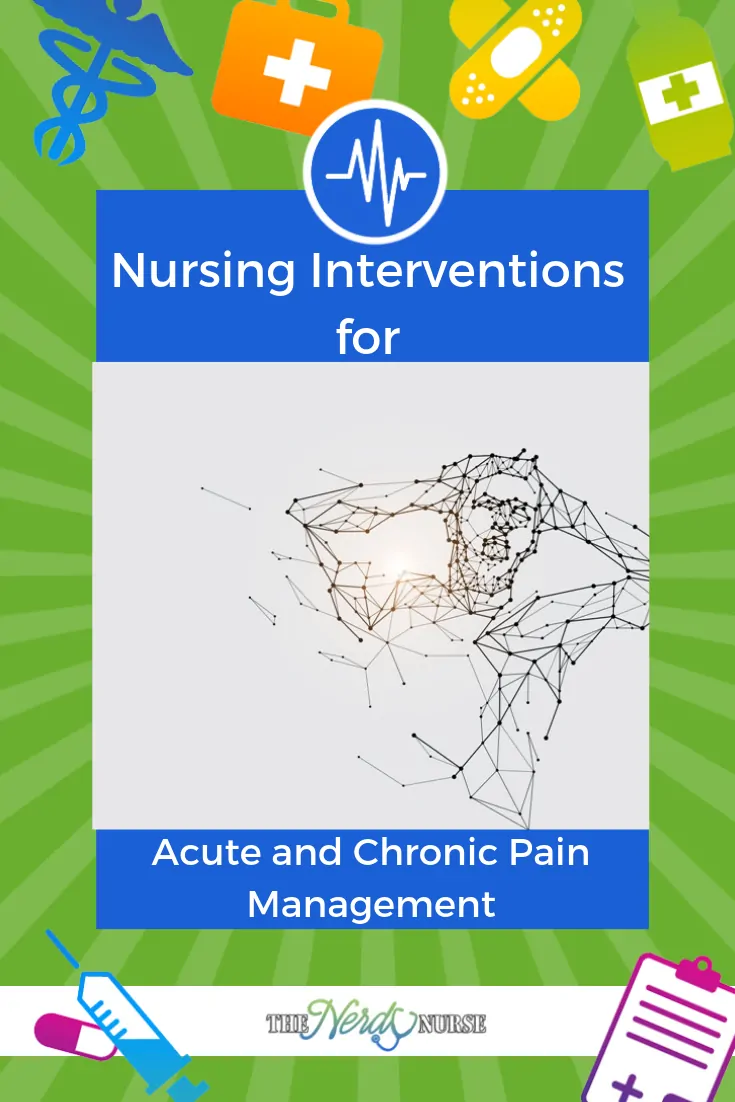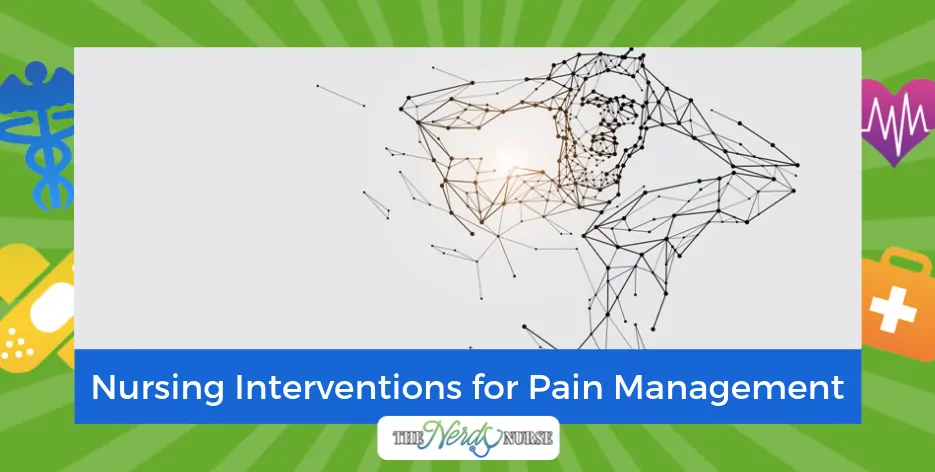As nurses, one of the most common things we will deal with is a patient’s pain management. It’s our job to assess it and then create a plan so the patient is comfortable.
What are all the different nursing interventions we can do? It often depends on which kind of pain it is. Is it chronic pain? Is it acute pain?
Let’s look at both kinds and the different nursing interventions we can use to manage their pain.
What is Pain?
Before we make a plan for managing the pain, let’s look at the basic definition of what pain is.
According to the Mayo Clinic, pain is:
A complex interaction between specialized nerves, your spinal cord and your brain.
Pain is very complex and subjective. It not only depends on the cause of the pain but the person experiencing it. As nurses, we have to understand our patients and respect their feelings. Some will have severe reactions while others might not react to the pain at all.
That is why it is so important to understand the difference between chronic and acute pain. There are different interventions depending on the type and severity of the pain.
Chronic Pain
Chronic is another word for ongoing. If your patient has dealt with the pain for at least 6 months, it can be classified as chronic. This covers all intensities of the pain, from mild to moderate to severe.
The Mayo Clinic considers chronic pain to be its own health condition worthy of specialized treatment.
Pay attention to whether the patient has cancer or not. Malignant chronic pain is pain associated with cancer. Non-malignant means there isn’t any cancer associated with the pain.
Acute Pain
Acute pain is severe or sudden pain that ends within a certain amount of time. Often this kind of pain is caused by an injury or an illness.
The helpful thing about acute pain is that the patient will be able to describe where it hurts. This means your interventions will be more specific and targeted.
Nursing Care Plan for Acute Pain Management
The first thing you will do before creating a nursing care plan for pain management is to identify the type of pain. After you know whether it is chronic or acute pain, you are ready to create a plan.
First, let’s look at how to manage acute pain.
1. Assess the Cause
Since acute pain is often the result of an injury or illness, when you treat the injury you will be managing the pain. Always try to figure out what is causing the pain, don’t just treat the pain itself.
2. Identify Non-Verbal Indicators of Pain
We all want to trust our patients, but sometimes they don’t want to verbalize their pain so you have to observe other indicators of pain. What are their facial expressions? Are they groaning or grimacing? What are their vital signs?
This is also very important when you have shy children or patients that aren’t able to describe their pain, even with a chart.
3. Focus on Function over Numbers
Often a goal should be improved sleep or mobility more than numbers on a chart. And since pain is so subjective, you have to rely on how they are acting and what their experience is. Create actionable goals. How well are they sleeping? Are they able to move around?
Work with the family and make the entire atmosphere one of helping them heal.
4. Anticipate The Need Before It Arises
Successful pain management gets ahead of the pain instead of reacting to it. You don’t want them going back to the pain and calling for you.
5. Use Alternative Therapies
Medicines aren’t the only way to treat pain. Work with the patient and their families to suggest alternative therapies like creating a calming environment, aromatherapy, and guided imagery.
And chart the patient’s experience so other nurses and physicians will know what works.
6. Try Medicinal Therapies When Appropriate
Of course, nurses can’t prescribe medications, but they can be a suggestion and part of the care plan. Always ask family members about addictions or personal reactions. Stay on top of the pain with the medications and treat them with care.
7. Review the Effectiveness
Every nurse should be charting and documenting the effectiveness – or lack – of each type of treatment. When something is working, keep it up. If something else needs to be changed or isn’t working as well, try to find something that will
8. Keep Clear Records and Documentation
Finally, as a nurse, it is our job to keep clear records. The documents we keep will help other nurses and physicians to continue to treat the pain in a way that is effective.
This is especially important if there are side effects to medications or personal reactions that are more negative.
Nursing Care Plan for Chronic Pain Management
The next type of pain that your patients might experience is chronic pain. Managing chronic pain is much more difficult. Since the threshold is 6 months, it can be difficult to pinpoint the cause of the pain. You also have to deal with the possibility that it’s a patient that doesn’t have any pain at all.
Here are some things that should be part of your nursing care plan for chronic pain management.
1. Assess the Patient
The first part should always be assessing the patient. What are their symptoms? Where do they say it is hurting? How bad does it hurt?
All of these answers should always go on their charts.
2. Create Customized Goals
Next, work with the patient and/or their family to create customized goals. The goals should be functional over numeric. Maybe you want to help them sleep better and engage more. Or maybe the goal is to live life in spite of the pain.
3. Discuss Past Use of Opioids
Another thing you will have to put on the care plan is whether they have ever had a problem with addicting pain killers. Maybe they will want a care plan that avoids pharmaceuticals. Put this in their records and tell the physician.
4. Discuss Combining Medications
Even though a nurse cannot prescribe pain killers, it is possible to suggest something to the family and the doctor. Discuss the possibility of combining medications and trying to find something that works together. There are analgesics: NSAIDs, opioids, and nonopioids.
5. Encourage Non-Medicinal Interventions
Some of the non-pharmaceutical interventions that you can put on the care plan include massage, guided imagery, and breathing techniques. See which they are open to trying and include those.
6. Monitor and Manage Side Effects
If you have someone on strong pain medications, keep watch for any and all side effects. As you know, that list can be very long. You might have to manage the side effects or try to find a different medication or way to manage the pain.
7. Evaluate and Keep Detailed Records
Finally, it is of supreme importance that you record every reaction as it could be a side effect to the medication. Monitor physical reactions, not just the patient’s verbal requests or how they say they feel.
Pain Management is Personal
Above all, pain management is a very personal experience. No two people experience or handle pain in the same way. When you create your nursing care plan, you will have to create a new one for each patient.
Work with the family and the patient and give yourself grace. Eventually, you will all discover a plan that works to successfully help that person to manage their pain.
More Nurse Guides
Here are some more guides that will help you grow in your career as a nurse.
- What is a CNA: Certified Nursing Assistant
- What is an LPN: Licensed Practical Nurse
- How to Become a Lactation Consultant
Core Curriculum for Pain Management Nursing














